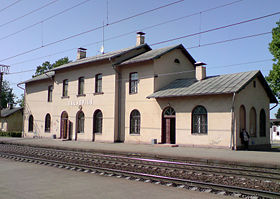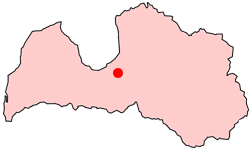Salaspils
| Salaspils | |
 |
|
 |
|
| Salaspils Railway Station in 2008. | |
 |
|
| Location of Salaspils within Latvia | |
| Location | |
| Other names | Holme (before 1186); Kircholm; Mārtiņsala |
|---|---|
| Mayor | Juris Putniņš |
| Number of city council members | 13 |
| District | Riga District |
| Area | 12 km2 (5 sq mi) |
| Rural territory | 115 km2 (44 sq mi) |
| Population | 21,102 |
| Density | 173 /km² (448 /sq mi) |
| Postal code | LV-2121; LV-2169 |
| Calling code | +371 67 |
| Time zone | EET (UTC+2) |
| Summer (DST) | EEST (UTC+3) |
| Homepage of Salaspils | |
Salaspils (pronunciation (German: Kirchholm) is a town 18 kilometers to the south-east of Riga, Latvia that gained town rights in 1993. The town is situated on the right bank of Daugava River.
Contents |
History
Salaspils is one of the oldest settlements in Latvia. Archaeological excavations of 1964-1975 (during the construction of Riga HES) in ancient settlements, burial grounds and castle mounds give evidence of very dense population of the region. During the excavations which were the largest in the history of Latvian archaeology, on the right bank of the Daugava the oldest ever known settlement of indigenous Latvians – Salaspils Laukskola (Country School of Salaspils) was found. 11,000 years ago reindeer hunters had settled there. From the 10th to 15th century, the site was settled by the Livonian and Baltic tribes.
At the end of the 12th and in the beginning of 13th century especially important not only for the history of the region but also for the Latvian ancient history was the small island on the Daugava – Mārtiņsala – which was an important Daugava Liv centre. The first stone castles and Christian churches were built at the nearby Ikšķile and on Mārtiņsala island. This is where the events described in the Livonian Chronicles – christening and gradual subjection of the local Liv tribes – took place. It is possible that around that time the Catholic church was established in the area, because in 1197 the first Christian cemetery in Latvia was consecrated on the island. In 1206 the Liv chieftain Ako organized the first revolt against the German crusaders but suffered defeat.
The Latvian name of the Salaspils comes from the Mārtiņsala Island castle, but the Germanized name Kircholm – from the Mārtiņsala Island church. Both names were referred to the territory on the right bank of the Daugava ruled by the Livonian Order.
In the XIV century, in 1380 the Livonian Order built their own castle (Neu-Kircholm) on the castle mound and the small St George’s church next to it. The impressive castle was an important support on the waterway to Riga. In XV-XVI century a small town was set up around the castle, but Salaspils (Neu-Kircholm) was destroyed in 1577 during the Livonian War.
In 1605 the town was a site of the Battle of Kircholm in which forces of the Polish-Lithuanian Commonwealth defeated the much more numerous army of Sweden. This was the biggest battle of the Polish-Swedish war. The battle took place near St George’s church and about 9000 Swedish soldiers were buried there. Two memorial stones in Salaspils remind of one of the biggest battles in Europe in the 17th century – they are the stones in memory of the survival of the Swedish king Karl IX and the brilliant victory of the Polish-Lithuanian forces. Up to the second part of the 20th century a magnificent 17th century military fortification rose at the Daugava – the Swedish rampart. The destroyed church was renovated in 1631, but later – in 1896 and 1923 - rebuilt.
In the 17th-19th century the life in the surroundings of Salaspils was set up mainly by two local estates – the Salaspils Estate which was established near the destroyed Order’s castle and belonged to Riga since 1630 and the Kurtes Estate which was situated in the territory of present Līvzemes street in Salaspils.
The Riga – Daugavpils railway was installed in 1861. A new centre of the inhabited territory set up near Salaspils station just opposite the Kurtes Estate. Shock’s greenhouse was transferred from Riga to Salaspils.
In the second part of the 19th century, military summer camps were organized in the territory of Salaspils and an Orthodox church was built for the needs of garrison. The 20th century started with the Revolution of 1905 and in connection with this Salaspils associates with a place of massive slaughter and punishment. During the World War I for two years the front line was at Salaspils, as a result many public buildings and farmsteads, as well as both churches were destroyed. Several burials of soldiers bearwitness the fierce battles of World War I on the Island of Death (Nāves sala), at the river Mazā Jugla, in other parts of Salaspils and its surroundings
During the first Republic of Latvia there were three parishes in Salaspils territory – Stopiņi, Salaspils (Ķesterciems) and Dole.
World War II
- See also: List of Nazi-German concentration camps
Salaspils experienced a number of tragic events during World War II. The German occupation authorities established Stalag-350-s, a camp for Soviet prisoners of war, in Salaspils. Two km from that camp in the nearby forest, the Nazi SS also established the largest occupation camp in the occupied Baltic for civilians. This camp was not listed in Nazi documents as a concentration camp, but instead it was officially designated a work and education camp (German: Arbeits- und Erziehungslager or AEL), a status similar to that of a prison. As such, it was directly subordinated to the HSSPF Ostland, the highest German police authority in the occupied Baltics.[1] By contrast, Nazi concentration camps (KZ) were generally subordinated to the WVHA, the economic exploitation administration of the SS. Many thousands of Jews from Latvia and other countries were interned in the camp at Salaspils starting the end of 1941. Conditions in this camp, among the worst in Latvia, led to heavy loss of life among the inmates.
The exact numbers of those who died at Stalag-350-s are the subject of ongoing debate. According to a report compiled in 1944 by the Soviet authorities, 43,000 captured Red Army personnel either were killed or died from diseases and starvation here.[1] Three other numbers have been mentioned in accounts published subsequently by Soviet historians. The history of the Latvian SSR printed in 1959 claims 56,000 people were killed. The Little Latvian Encyclopedia published in the 1970s claims 53,000 were killed. History textbooks published in the 1980s by the Soviet Union claim that over 100,000 people were killed in Salaspils. Similarly, archival documents of Soviet provenance recently published in Russia estimate the total number killed in Salaspils concentration camp to be 101,000.[2] Recent scholarship produced outside Russia questions the magnitude of these Soviet-era figures. The Latvian historian Heinrihs Strods[1] and the German Holocaust historians Andrej Angrick and Peter Klein[3] conclude that a more a realistic number of deaths at Salaspils is 2,000–3,000 in total, including children. At the site of Stalag-350-s, a major monument complex in remembrance of the Soviet victims of Nazism was opened on 31 October 1967.
Camp survivor H. Baermann, who was imprisoned at Salaspils from December 1941 to August 1942, reported that in this period 15,000 persons passed through the camp, and almost all of them were killed, only 192 survived.[4] According to another eye-witness account, by E. K. Salijums, Soviet children in particular were annihilated by the Nazis through "medical experiments", from which some 150 children died each day.[5] In total from 1942 to 1944 some 12,000 Soviet children passed through the camp, most of them being tortured by pumping out their blood (500 grams from each).[6] In one of the burial places by the camp 632 corpses of children of ages 5 to 9 were revealed, with total number of Soviet children killed in the camp estimated to be 7,000.[7]
City growth in '50s and '60s
During the late 1950s and early 1960s, various mutually unrelated soviet authorities started the development of industrial enterprises, governmental institutions and constructed large multiple-storied housing blocks. In a couple of decades Salaspils grew from a very peaceful rural settlement to a town with several separate housing estates. It was due to the construction of housing districts for the employees of Salaspils Nuclear Reactor, four institutions of the Academy of Science, the well-organized village of the former soviet state farm but especially the housing district of building-workers for the construction of Riga HES and Riga TEC-2.
Salaspils became an important centre of the Latvian power industry, science and agriculture. Unfortunately the post-war rapid land development and the construction of the water reservoir devastated the monuments of Salaspils ancient history. The oldest settlement site has been preserved only at Salaspils railway station.
During last 60 years the amount of the inhabitants has increased about 70 times – from 306 people in Salaspils and Ķesterciems in 1943 to 21,102 people in 2000.
In the rural territory next to big industrial enterprises (at Saulkalne, Acone) and at large-scale farming centres multi-storey living houses were built.
In 1979 Salaspils acquired the status of rural village and it was the largest rural inhabited place in Soviet Latvia with 14,000 inhabitants.
The industrial development has led to the population of Salaspils growing to 21,000. As of 2000 census, 42% of population is Latvian, 42% is Russian and 16% belongs to other ethnic groups.
Geography
The National Botanical Gardens
The National Botanical Gardens occupy 129 ha in the northern part of Salaspils between the railway and former peat extraction site. The National Botanical Gardens are famous for their richest plant collection in the Baltic States, as well as they have one of the biggest arboretums in the world. The gardens are open to visitors, their territory is used as a walkabout place by the inhabitants of Salaspils.
Nuclear reactor
The reactor site is located in the forest, to the west of the institute of physics, in the northeastern part of the town. The reactor was operational from 1969 to 1998. The plant partook in neutron activation analysis and gamma irradiation for various materials. It was a pool-type reactor. It is now being demolished.
See also
- Battle of Kircholm
References
- ↑ 1.0 1.1 1.2 Strods, Heinrihs (2000). "Salaspils koncentrācijas nometne (1944. gada oktobris – 1944. gada septembris". Yearbook of the Occupation Museum of Latvia 2000: pp. 87–153. ISSN 1407-6330. (Latvian)
- ↑ Latvia Under The Yoke Of Nazism: Collected Archive Documents, p. 10
- ↑ Angrick, Andrej; Klein, Peter (2006) (in German). Die "Endlösung" in Riga: Ausbeutung und Vernichtung 1941–1944. Darmstadt: Wissenschaftliche Buchgesellschaft. pp. p. 269. ISBN 3534191498. OCLC 69983159.
- ↑ Press, Bernhard (2000) [1992]. The Murder of the Jews in Latvia 1941–1945. trans. Laimdota Mazzarins. Evanston, Ill.: Northwestern University Press. pp. p. 133. ISBN 0810117290. OCLC 43317885. http://books.google.com/books?q=baermann+%22who+has+already+been+mentioned%22.
- ↑ (Russian) Latvia Under The Yoke Of Nazism: Collected Archive Documents, Moscow:Europe Publisher, 2006, p.83, available online
- ↑ Latvia Under The Yoke Of Nazism: Collected Archive Documents, p.86
- ↑ Latvia Under The Yoke Of Nazism: Collected Archive Documents, pp.86,87
|
|||||||||||
|
|||||